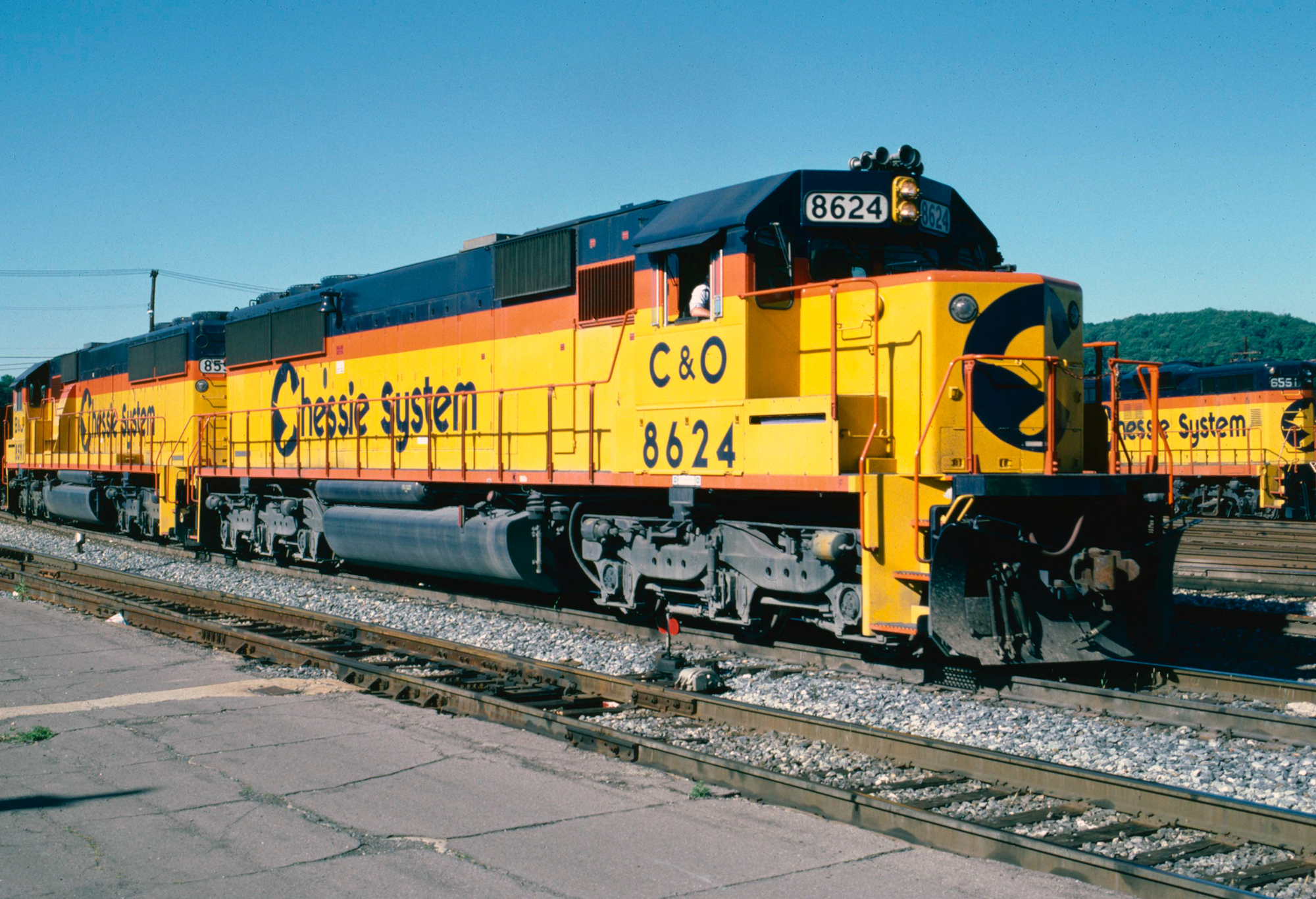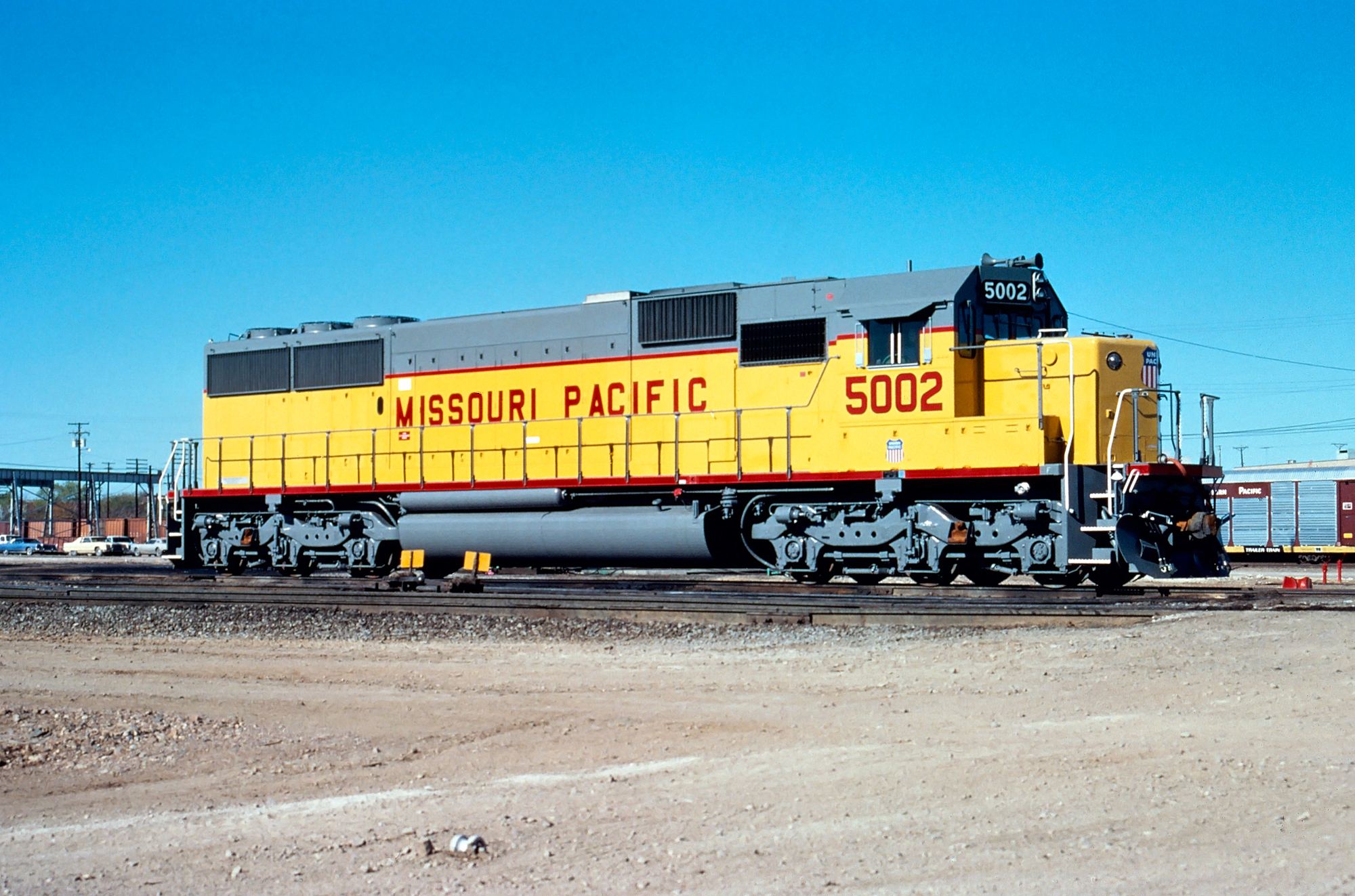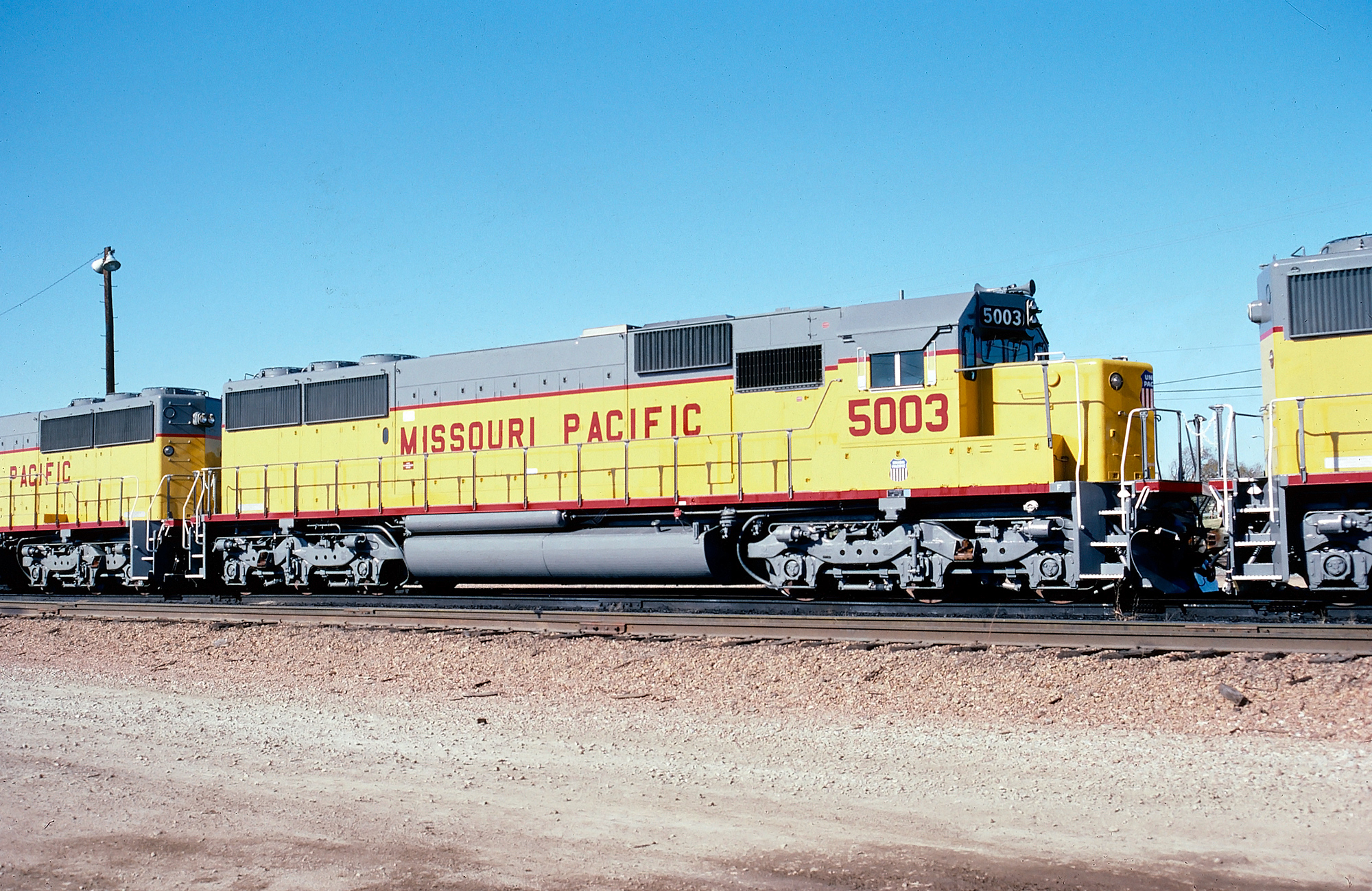EMD "SD50" Locomotives: Data Sheet, Specs, Roster
Last revised: December 16, 2024
By: Adam Burns
The SD50 was Electro-Motive's followup to its blockbuster SD40-2. As Greg McDonnell notes in his book, "Locomotives: The Modern Diesel & Electric Reference (Second Edition)," the '50 was essentially a transition model.
The standard production SD50 was cataloged only between November, 1984-May, 1985 and subsequently replaced by the SD60, equipped with EMD's latest 710 prime mover.
The sterling reputation of La Grange began to waver during the 1980s and the SD50 was a contributing factor. The builder attempted to push the 16-cylinder, 645 power plant to its very limits by achieving the same horsepower output as the 20-cylinder, 645E3 engine featured in the SD45.
However, much of the industry was weary of this decision and not surprisingly the SD50 did suffer from some mechanical issues. Ultimately, the model did sell more than 400 examples during its short production run.
In addition, from an operational standpoint, SD50s were generally well-liked by crews as they provided sufficient power and a comfortable ride.
Today, some rebuilt variants remain in service on Class 1s; CSX has upgraded theirs to SD50-2 and SD50-3 specifications - but derated to 3,000 horsepower. Norfolk Southern has carried out a similar program with its "SD40E" locomotives.
Photos
 Chessie System SD50s at Cumberland, Maryland in June of 1986. Photographer unknown. American-Rails.com collection.
Chessie System SD50s at Cumberland, Maryland in June of 1986. Photographer unknown. American-Rails.com collection.Background
When the SD50 debuted GE was already a well established builder making increasing inroads into the locomotive market and jeopardizing EMD's longstanding dominance.
Its "Dash 7" line was enjoying ever greater sales and ultimately would sell more than 1,100 examples. In addition, by the early 1980s it was in the process of testing its latest "Dash 8" series.
In essence, the SD50 was a transition to EMD's present-day highly computerized models, which began with the SD60 of 1984. It also concluded production of the 645 power plant.
As the builder moved beyond its "Dash 2" line it attempted to squeeze greater horsepower out of a 16-cylinder variant of the engine in an effort to achieve greater operational efficiency. EMD pushed the engine to its limit, initially as the 3,500 horsepower 645F3B.
SD40X
The second testbed model dubbed the "SD40X" - the first had been built in 1964-1965 to showcase EMD's early SD40 line - four were produced at La Grange in 1978 carrying a 645F3 prime mover.
They were manufactured utilizing a standard SD40-2 frame and used every bit of available space to house new components and EMD's reconfigured layout.
The testbeds included new features like exhaust silencers, Q-series "quiet" radiator fans, and the Super Series wheel slip control system first tested on the SD40-2SS. They also included improvements to the electrical system and microprocessor advancements.
From a visual aspect this SD40X was a radical departure from all previous EMD designs. The builder removed the dynamic brake resistors entirely from the top of the hood - where they had traditionally been centered over the prime mover - and relocated within a six-foot section between the cab and central air intake.
In doing so, the SD40X carried a generally clean roofline. The units were eventually purchased by Kasnas City Southern as 700-703 and delivered in September, 1979. One other noteworthy change was the enlarged rectangular rear radiator grilles; a trait also shared by the four-axle GP50.
 Missouri Pacific/Union Pacific SD50 #5002, only a few months old, lays over in Fort Worth, Texas in March, 1985. Steve Bledsoe photo. American-Rails.com collection.
Missouri Pacific/Union Pacific SD50 #5002, only a few months old, lays over in Fort Worth, Texas in March, 1985. Steve Bledsoe photo. American-Rails.com collection.Norfolk & Western received the very first production model SD50s, #6500-#6506, delivered in December, 1980. Interestingly, these first examples were also built on the SD40-2 frame, the only of their kind.
To provide additional space for equipment, all future SD50s rode on the lengthened 71 foot, 2-inch frame; the first examples included Kansas City Southern #704-713 completed in the spring of 1981.
In an effort to differientiate N&W's early units, EMD designated these as the "SD50S." The SD50 was also the last La Grange model cataloged solely with the Spartan Cab. The later SD60 was offered with the now popular (and mandatory) wide, "safety" cab design.
Data and Specifications
| Entered Production | 5/1981 (Kansas City Southern #704) |
| Years Produced (SD50) | 5/1981 - 2/1986 |
| Years Produced (SD50S) | 12/1980 |
| Engine | 645F3B/645F3C |
| Engine Builder | GM |
| Horsepower | 3500/3600 |
| RPM | 904 |
| Cylinders | 16 |
| Length (SD40X/SD50S) | 68' 10" |
| Length (SD50) | 71' 2" |
| Height (Top Of Rail To Top Of Cab) | 15' 7 ½" |
| Width | 10' 3" |
| Weight | 368,000 Lbs |
| Fuel Capacity | 3500 Gallons |
| Air Compressor | Gardner-Denver |
| Air Compressor Model | WBO |
| Air Brake Manufacturer | Westinghouse |
| Air Brake Schedule | 26L |
| Trucks | C-C |
| Truck Type | HT-C |
| Truck Wheelbase | 13' 7" |
| Wheel Size | 40" |
| Traction Motors | D87Y/D87A (6), GM |
| Primary Generator | AR16/AR11, GM |
| Auxiliary Generator | Delco (A8102) |
| Alternator | D14 |
| MU (Multiple-Unit) | Yes |
| Dynamic Brakes | Yes |
| Gear Ratio | 62:15 |
| Tractive Effort (Starting) | 92,000 Lbs at 25% |
| Tractive Effort (Continuous) | 82,100 Lbs at 11 mph |
| Top Speed | 65 mph |
Production Roster
SD40X
Total Built = 4
| Owner | Road Numbers | Serial Numbers | Completion Date |
|---|---|---|---|
| Kansas City Southern | 700-701 | 786285-1 thru 786285-2 | 9/1979 |
| Kansas City Southern | 702-703 | 786286-1 thru 786286-2 | 9/1979 |
SD50
Total Built = 431
| Owner | Road Number(s) | Serial Number(s) | Completion Date |
|---|---|---|---|
| Kansas City Southern | 704-713 | 806044-1 thru 806044-10 | 5/1981-6/1981 |
| Seaboard System | 8500-8524 | 817046-1 thru 817046-25 | 1/1983-2/1983 |
| Norfolk Southern | 6506-6520 | 827041-1 thru 827041-15 | 7/1984 |
| Conrail | 6700-6739 | 837047-1 thru 837047-40 | 10/1983-12/1983 |
| Seaboard System | 8527-8552 | 837048-1 thru 837048-26 | 2/1984-3/1984 |
| Chesapeake & Ohio | 8553-8575 | 837057-1 thru 837057-23 | 1/1984-2/1984 |
| Conrail | 6740-6779 | 837065-1 thru 837065-40 | 4/1984-6/1984 |
| Seaboard System | 8525-8526 | 837068-1, 837068-2 | 3/1984 |
| Norfolk Southern | 6521-6525 | 837073-1 thru 837073-5 | 07/1984 |
| Seaboard System | 8596-8602 | 837080-1 thru 837080-7 | 6/1984 |
| Baltimore & Ohio | 8576-8595 | 837081-1 thru 837081-20 | 7/1984-8/1984 |
| Missouri Pacific | 5000-5059 | 847008-1 thru 847008-60 | 11/1984-12/1984 |
| Seaboard System | 8603-8623 | 847017-1 thru 847017-21 | 1/1985-2/1985 |
| Denver & Rio Grande Western | 5501-5517 | 847022-1 thru 847022-17 | 8/1984-9/1984 |
| Conrail | 6780-6804 | 847032-1 thru 847032-25 | 4/1985-5/1985 |
| Chicago & North Western | 7000-7034 | 847049-1 thru 847049-35 | 11/1985-12/1985 |
| Conrail | 6805-6834 | 857080-1 thru 857080-30 | 1/1986-2/1986 |
| Chesapeake & Ohio | 8624-8643 | 857095-1 thru 857095-20 | 10/1985-11/1985 |
SD50S
Total Built = 6
| Owner | Road Numbers | Serial Numbers | Completion Date |
|---|---|---|---|
| Norfolk & Western | 6500-6505 | 806030-1 thru 806030-6 | 12/1980 |
These six examples were identical to the standard SD50 line except for their SD40-2 frames, which was 2' 4" shorter. These same frames had been used on Kansas City Southern #700-703, which were designated as SD40X's although were otherwise SD50's internally.
Electro-Motive's use of "S" in the SD50S variant was unknown although apparently meant "short." The units originally featured an older blower duct but were returned to EMD in October, 1981 and equipped with the free-flow system.
General Motors Diesel Division (GMDD)
SD50F
Total Built = 60
| Owner | Road Number(s) | Serial Number(s) | Order Number | Completion Date |
|---|---|---|---|---|
| Canadian National | 5400-5424 | A4472-A4496 | C455 | 4/1985-8/1985 |
| Canadian National | 5425-5439 | A4547-A4561 | C455 | 8/1985-2/1986 |
| Canadian National | 5440-5459 | A4617-A4636 | C461 | 2/1987-7/1987 |
Export
SDL50
T0tal Built = 31
| Owner | Road Numbers | Serial Numbers | Completion Date |
|---|---|---|---|
| Saudi Government Railway | 3500-3505 | 808047-1 thru 808047-6 | 12/1981 |
| Saudi Government Railway | 3506-3515 | 838085-1 thru 838085-10 | 12/1984 |
| Saudi Government Railway | 3516-3522 | 958646-1 thru 958646-7 | 11/1997-12/1997 |
| Saudi Government Railway | 3523-3530 (assembled by ITS Rail at Paducah, Kentucky) | 20038550-1 thru 20038550-8 | 8/2005 |
 A group of new Missouri Pacific/Union Pacific SD50's, about a month old, at Fort Worth, Texas on December 2, 1984. Steve Bledsoe photo. American-Rails.com collection.
A group of new Missouri Pacific/Union Pacific SD50's, about a month old, at Fort Worth, Texas on December 2, 1984. Steve Bledsoe photo. American-Rails.com collection.In 1984, EMD increased the SD50's output from 3,500 to 3,600 horsepower via the final 645 variant, the 645F3C. Models produced after this time also featured an updated AR11 alternator (in place of the AR16) and D87A traction motors, which replaced the previous D87Y.
Only one variant was produced, the SD50F. Requested solely by the Canadian National this "cowl" design featured a full length carbody and CN's wide "safety" - or "comfort" - cab. Produced at GMD's London, Ontario facility CN wound up with 60 units, completed between 1985-1987.
Sources
- Foster, Gerald. A Field Guide To Trains. New York: Houghton Mifflin, 1996.
- Marre, Louis A. and Pinkepank, Jerry A. Contemporary Diesel Spotter's Guide, The: A Comprehensive Reference Manual To Locomotives Since 1972. Milwaukee: Kalmbach Publishing Company, 1989.
- Marre, Louis A. Contemporary Diesel Spotter's Guide, The: A Comprehensive Reference Manual To Locomotives Since 1972, Including Rebuilding, Upgrading, And Leasing Programs (2nd Edition). Milwaukee: Kalmbach Publishing Company, 1995.
- Solomon, Brian. American Diesel Locomotive, The. Osceola: MBI Publishing, 2000.
- Solomon, Brian. EMD Locomotives. Minneapolis: MBI Publishing Company, 2006.
- Solomon, Brian. GE and EMD Locomotives: The Illustrated History. Minneapolis: Voyageur Press, 2014.
Recent Articles
-
Rio Grande 2-8-2 Locomotives (K-37): Specs, Roster, Photos
Apr 15, 25 12:57 PM
Rio Grande's Class K-37 Mikes were itsdge steamers to enter service in the late 1920s. Today, all but two survive. -
Rio Grande 2-8-2 Locomotives (K-36): Specs, Roster, Photos
Apr 15, 25 11:09 AM
The Rio Grande's K-36 2-8-2s were its last new Mikados purchased for narrow-gauge use. Today, all but one survives. -
Rio Grande 2-8-2 Locomotives (Class K-28): Specs, Roster, Photos
Apr 14, 25 10:24 PM
Rio Grande's Class K-28 Mikados were its newest narrow-gauge steam locomotives since the Mudhens of the early 1900s. Today, three survive.


